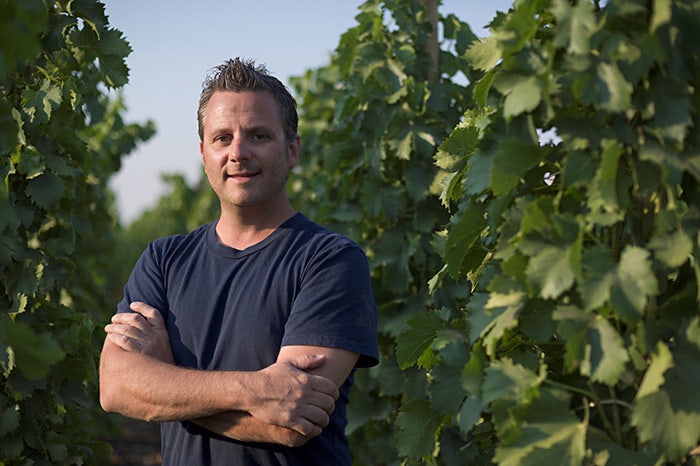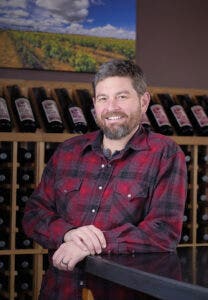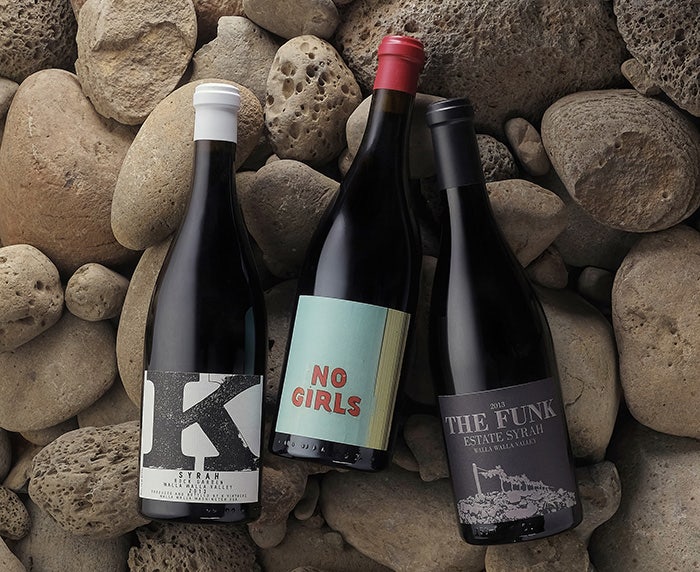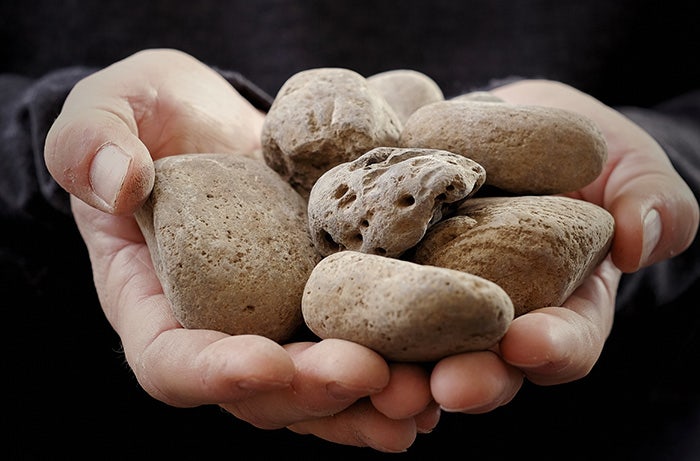Rocks region pioneer Christophe Baron didn’t set out to discover a new wine-growing territory when he first moved to the Walla Walla Valley from his native France in 1993. In fact, he didn’t really look to live in the Walla Walla Valley, which straddles the Oregon-Washington border, at all.
“Being crazy about Chardonnay and Pinot Noir from Burgundy, my goal really was to work in the Willamette Valley,” he says. But the only job he could find there was working harvest.
When a friend told him about a longer-term position opening up in Walla Walla, he did what any person might do in those pre-internet days. He looked at an atlas.
“I looked at Walla Walla, and I looked at the Willamette Valley, and said, ‘Sure,’ ” he recalls. “I thought it was very close. I figured I’d be going to the Willamette Valley every weekend.”
What Baron didn’t realize at the time, however, was that the two areas are more than five hours apart.
“I didn’t know anybody. I didn’t have any equipment. I came with all of my savings, and thankfully, I was able to get some vines. I was starting really from scratch as a French guy coming to Walla Walla.” —Christophe Baron
“My first weekend off, I drove my convertible from Walla Walla to the Willamette Valley, and I realized for the first time how big the country was,” he says with a laugh.
Baron spent a year there, followed by a series of stints in the Willamette Valley, Australia and New Zealand. In the spring of 1996, he returned to the U.S. to purchase land in the Willamette Valley’s Dundee Hills. On the way, he made a fateful stop back in Walla Walla.
“Everywhere I went, I brought my French wine atlas,” Baron says. “I showed a friend the stones of Châteauneuf-du-Pape. He said, ‘I know where there’s stones like that.’”
Baron was intrigued. Early the next morning, he and his friend made the 20-minute drive down to the town of Milton-Freewater, on the Oregon side of the Walla Walla Valley. They came to a field littered with cobblestones.
“I bent over and grabbed a few stones and said, ‘Well, this is it,’ ” says Baron. “I knew right then I was going to buy the land and plant a vineyard.”

Rocky beginnings
Baron’s knowledge of the stones of Châteauneuf-du-Pape and experience with cobblestone soils in New Zealand told him he was on to something.
“I knew I had something special in front of me,” he says. “I knew that the stones would produce great fruit and be able to create great wines.”
Not everyone was so sure.
“I remember many people saying, ‘I don’t think he knows what he’s doing.’ ” says Richard Funk, owner of Saviah Cellars in Walla Walla. “People thought he was crazy.”

The area, which would later come to be referred to as The Rocks, is a former riverbed of the Walla Walla River. The soil is studded with fist-sized basalt cobblestones washed down from the Blue Mountains to the east. Long known for its apple and cherry orchards, wine grapes hadn’t been planted in the area for generations.
Planting the vines wasn’t easy. The rocky soil required 50-pound crowbars to pry through the stones.
“It was a lot of work,” says Baron. “I didn’t know anybody. I didn’t have any equipment. I came with all of my savings, and thankfully, I was able to get some vines. I was starting really from scratch as a French guy coming to Walla Walla.”
At his first vineyard, Baron focused on Syrah.
“That was the new thing at the time in Washington,” says Baron. “And I knew that it would grow well there, because Syrah transpires terroir.”
Initially, people didn’t support Baron’s efforts, but opinions changed once they tried his early wines.
“When I tasted those first Syrahs, I thought, ‘It must be some French technique,’ ” says Funk. “There was an aromatic profile that was so different and so unique from anything else that I was tasting.”
Baron’s wines inspired more people to plant vineyards in The Rocks, which Baron prefers to call The Stones. The area would become known for its distinctive aroma and flavor profile.

“Typically, when people talk about wine, they talk about the fruit,” says Trey Busch, winemaker and co-owner of Sleight of Hand Cellars in Walla Walla. “Well, fruit is like the eighth or ninth adjective when you’re smelling Rocks wines. It’s all savory characteristics. It’s meat and brine and olive and saline and mineral and bacon fat.”
The wines are also notable for an earthy quality initially referred to as “Cayuse funk,” after Baron’s first winery, Cayuse Vineyards. Now, it’s simply known as “Rocks funk.” The naturally high pH gives the wines a distinct mouthfeel.
“They’re soft and silky and plush and lush,” says Chad Johnson, co-owner and winemaker at Dusted Valley Vineyards. “Very hedonistic.”
The Science of Stony Soils
Why exactly are these wines so distinctive? It’s the stones, of course.
“It is a fundamentally different soil type than the surrounding agricultural area,” says Kevin Pogue, a geology professor at Whitman College in Walla Walla, and head of VinTerra, a vineyard consulting service. “Most of the surrounding soils are granitic in nature.
“Because the Rocks and the surrounding soil are derived from basalt, the soils are much higher in iron, magnesium and titanium,” he explained. “So it’s chemically different, it’s texturally different and it’s also excessively drained, because it’s pretty much all coarse-grained material.”

Pogue says that the rocks have unique thermal properties, too, their dark color absorbing the sun’s heat and transmitting it into the deeper layers of the soil. This leads to an earlier budbreak than the surrounding areas of the valley.
The stones also radiate heat up toward grape clusters during the day.
“I measured temperatures in grape clusters in grapes trellised a couple of feet above the rocks, and the grapes get considerably warmer than grapes trellised two feet above grass-covered vineyards in the surrounding hills,” says Pogue.
That contributes to the unique ripeness and structure obtained in the region’s wines.
“It was my desire to make it the most terroir-driven appellation in the country.” —Kevin Pogue
While Rocks Syrahs have telltale aromatic and flavor characteristics, the wines also show some intriguing variations. These differences are best explored through the single-vineyard Syrahs that Baron produces for his three wineries, Cayuse Vineyards, No Girls and Horsepower Vineyards.
“For me, it’s all about each site and the personality and individuality of each site,” says Baron. “That has been my goal since Day One. That’s what I am completely obsessed by.”
Harnessing the Terroir
Though The Rocks are distinctive and capable of making wine of stratospheric quality—more than 50 of Baron’s wines have earned 95 points or more from Wine Enthusiast—working there presents challenges.
“It’s very expensive to plant and farm in the area,” says Funk. “You’re beating the tar out of your equipment, and it’s hard on your people.”

Johnson agrees. “Everything is literally almost twice as hard, because you can’t drill anything and it’s hard to drive posts. Everything costs that much more.”
The area is also susceptible to spring and fall frosts and hard winter freezes. As a result, wind machines, which help prevent frost damage, are common, and some growers bury vine canes to protect them from harsh winters.
While Syrah is unquestionably the star, varieties like Grenache, Tempranillo and Cabernet Sauvignon have also excelled.
“The Grenache is more distinctive than anywhere else in the world,” says Baron. “It’s completely unique.”
In 2015, The Rocks area was awarded its own appellation, The Rocks District of Milton-Freewater American Viticultural Area (AVA), named after the closest town. A subappellation of the Walla Walla Valley that’s wholly contained in Oregon, the 3,767-acre area now has 300 acres under vine.
“It was my desire to make it the most terroir-driven appellation in the country,” says Pogue, who was contracted to write the AVA application by a group of local winery and vineyard owners. “It’s 97 percent one soil series. It’s remarkably consistent in terms of soils, aspect, slope and elevation—all of the principle characteristics that come together to make terroir.”
While dozens of other producers now make wines from The Rocks, Baron has a years-long waiting list to purchase his wines. Still, he continues to innovate.
For his recent Horsepower Vineyards project, the vines are planted at three-foot intervals, which makes for a vine density of 4,840 vines per acre. That far outdistances the 1,000 vines per acre that’s typical in the Northwest. Because of the tight spacing, the rows are ploughed by draft horse.
“I am always trying to push the boundaries,” says Baron. “Push and push and push and push. Trying to really see how far we can go in terms of creating true vin de terroir, a wine of terroir.”
Now, 20 years in, Baron believes he’s just getting started.
“As a vigneron, I’ve just scratched the surface. For me, the wines are very good, but they can be so much better.”

Rock Out With These Bottles
Horsepower 2013 The Tribe Vineyard Syrah (Walla Walla Valley); $120, 96 points. This wine is aromatically brooding but precise, with notes of umami, black olive, smoked ham, crushed violets, funk and peat. The flavors are hefty and concentrated—with notes of fire pit and wet stone—while showing earth-shaking depth and intensity. The finish stretches out as long as you care to count. This is a complete knee buckler.
Cayuse 2013 Cailloux Vineyard Syrah (Walla Walla Valley); $80, 95 points. The aromas are perfumed and expressive, with notes of crushed flowers, brown stems, black olive, sea salt, smoked meat and funk. The flavors are dense and intense, but still with a silky feel. It’s a classic example of this producer, with a finish that just won’t quit. Editors’ Choice.
Delmas 2014 SJR Vineyard Syrah (Walla Walla Valley); $65, 94 points. Viognier makes up just over 8% of this wine and it shows itself with perfumed aromas of flowers and orange peel, along with brown stems, freshly ground herb, black olive, mineral and whiffs of smoked meat. The palate is all about texture and layers, while never losing its exquisite sense of balance, gliding on the extended finish. Superb stuff, with an emphasis on elegance.

K Vintners 2013 Rock Garden Syrah (Walla Walla Valley); $60, 94 points. Coming off The Rocks District, this wine displays high-toned aromas of brown stems, crushed violets and black pepper along with a light meat and olive streak. The flavors are poised and layered, showing a mixture of red and black fruits with abundant savory accents. The crazy-long finish flat out impresses.
No Girls 2013 La Paciencia Vineyard Grenache (Walla Walla Valley); $75, 94 points. The aromas pop with notes of fresh flowers, smoked meat, stems, mineral, smoke, white pepper and an earthy funk. The flavors dance on the palate, with mouthwatering fruit and savory notes that lead to an outrageously long finish. It’s equal parts elegance and intensity.
Saviah 2013 The Funk Estate Syrah (Walla Walla Valley); $60, 94 points. The aromas of this wine pop, with notes of fresh flowers, green herbs, olive brine, coffee, grilled asparagus, gravel and a touch of smoked meat lurking in the background. The fruit and savory flavors are plush and palate-coating in feel, with floral and smoked meat notes persisting on the finish. It’s a very pretty interpretation of the area, with a compelling sense of balance. Editors’ Choice.

La Rata 2013 Red (Walla Walla Valley); $70, 93 points. Grenache takes the lead, making up 60% of this wine, which was co-fermented with Cabernet. Generous aromas of earth, white pepper, herbs, flowers, funk, smoked salt and crushed strawberry lead to a palate chock-full of smoked meat and savory flavors. It shows a beautiful sense of elegance and grace that belies the richness and length of the fruit and savory flavors. Editors’ Choice.
Dusted Valley 2014 Tall Tales Stoney Vine Vineyard Syrah (Walla Walla Valley); $60, 92 points. Coming from the winery’s estate vineyard in The Rocks District, this aromatic brooder shows notes of crushed flowers, wet stone, orange peel, brown stems and dark fruit, along with light smoked meat accents. The palate boasts generous fruit and savory flavors that linger on the finish.
Proper 2014 Estate Syrah (Walla Walla Valley); $48, 92 points. The aromas jump up, with mesmerizing notes of fresh herbs, green olive, violets, orange peel, smoked meat and huckleberry. The palate shows a light but pillowy texture alongside flavors that carry on the finish. It’s all about subtlety.

Reynvaan 2013 In the Rocks Vineyard Estate Syrah (Walla Walla Valley); $70, 92 points. The aromas pop with notes of wet gravel, mineral, funk, olive tapenade and high-toned flowers. The flavors are palate coating yet light and restrained, with generous savory and umami flavors that draw out on the finish. It has a very pretty sense of texture and precision—all about elegance.
Sleight of Hand 2014 The Psychedelic Stoney Vine Vineyard Estate Syrah (Walla Walla Valley); $60, 92 points. Coming off The Rocks District, this wine displays somewhat reserved notes of ember, smoked meat, green olive, wet stone and smoke, leaning hard into the savory. The charcuterie, smoke and licorice flavors coat the palate, stretching out on the finish.
Buty 2013 Rediviva of the Stones Rockgarden Estate Red (Walla Walla Valley); $60, 91 points. A blend of Syrah (80%), Cabernet Sauvignon (14%) and Mourvèdre, this opens with aromas of wet gravel, herb, smoke, funk, nori and black olive that are followed by plentiful, soft, generous savory flavors that bring a lot of intensity and appeal. The finish lingers.
Last Updated: May 4, 2023















